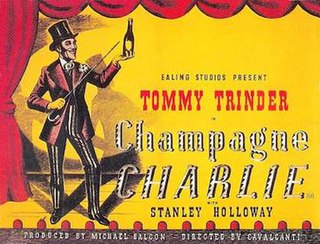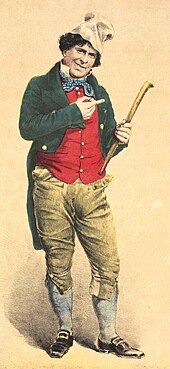
Islington is a district in the north of Greater London, England, and part of the London Borough of Islington. It is a mainly residential district of Inner London, extending from Islington's High Street to Highbury Fields, encompassing the area around the busy High Street, Upper Street, Essex Road, and Southgate Road to the east.

George Leybourne was a Lion comique of the British Victorian music hall who, for much of his career, was known by the title of one of his songs, "Champagne Charlie". Another of his songs, and one that can still be heard today, is "The Daring Young Man on the Flying Trapeze". His 1867 hit "Champagne Charlie" led to the first major success of the music hall concept in Britain, and he remains among the best known music hall performers.

Music hall is a type of British theatrical entertainment that was most popular from the early Victorian era, beginning around 1850, through the Great War. It faded away after 1918 as the halls rebranded their entertainment as variety. Perceptions of a distinction in Britain between bold and scandalous Music Hall and subsequent, more respectable Variety differ. Music hall involved a mixture of popular songs, comedy, speciality acts, and variety entertainment. The term is derived from a type of theatre or venue in which such entertainment took place. In North America vaudeville was in some ways analogous to British music hall, featuring rousing songs and comic acts.

George Wild Galvin, better known by the stage name Dan Leno, was a leading English music hall comedian and musical theatre actor during the late Victorian era. He was best known, aside from his music hall act, for his dame roles in the annual pantomimes that were popular at London's Theatre Royal, Drury Lane, from 1888 to 1904.

Champagne Charlie is a 1944 British musical film directed by Alberto Cavalcanti and loosely based on the rivalry between the popular music hall performers George Leybourne, who was called "Champagne Charlie" because he was the first artist to perform the song of that title, and Alfred Vance, who was known as "The Great Vance".

Francis Matcham was an English architect who specialised in the design of theatres and music halls. He worked extensively in London, predominantly under Moss Empires, for whom he designed the Hippodrome in 1900, Hackney Empire (1901), Coliseum (1903) and Palladium (1910). His last major commission before retirement was the Victoria Palace (1911) for the variety magnate Alfred Butt. During his 40-year career, Matcham was responsible for the design and construction of over 90 theatres and the redesign and refurbishment of a further 80 throughout the United Kingdom.

Thomas Edward Trinder CBE was an English stage, screen and radio comedian whose catchphrase was "You lucky people!". Described by cultural historian Matthew Sweet as "a cocky, front-of-cloth variety turn", he was one of the United Kingdom's foremost entertainers during the Second World War.

Greenwich Theatre is a local theatre located in Croom's Hill close to the centre of Greenwich in south-east London.

William Henry Crump, better known by the stage name Harry Champion, was an English music hall composer, singer and comedian, whose onstage persona appealed chiefly to the working class communities of East London. His best-known recordings include "Boiled Beef and Carrots" (1909), "I'm Henery the Eighth, I Am" (1910), "Any Old Iron" (1911) and "A Little Bit of Cucumber" (1915).

Charles Courtice Pounds, better known by the stage name Courtice Pounds, was an English singer and actor known for his performances in the tenor roles of the Savoy Operas with the D'Oyly Carte Opera Company and his later roles in Shakespeare plays and Edwardian musical comedies.

The Music Hall Strike of 1907 was a theatrical dispute which took place between music hall employees, stage artistes and London theatre proprietors. The catalyst for the strikes were the employees' lack of pay, the scrapping of perks, and an increase in working hours, and matinée performances.

Herbert Campbell, born Herbert Edward Story, was an English comedian and actor who appeared in music hall, Victorian burlesques and musical comedies during the Victorian era. He was famous for starring, for many years, in the Theatre Royal, Drury Lane's annual Christmas pantomimes, predominantly as a dame.

Harry Liston was an English comedian and actor who appeared in music hall, variety shows and other entertainments during the Victorian era and in the first decades of the 20th century.
The Metropolitan Theatre was a London music hall and theatre in Edgware Road, Paddington. Its origins were in an old inn on the site where entertainments became increasingly prominent by the early 19th century. A new theatre was built there in 1836, replaced in 1897 by a new building designed by the theatre architect Frank Matcham. The Metropolitan was a leading theatre for music hall and variety, but with the decline of the latter in the mid-20th century it struggled to survive, and was demolished in 1964 to make way for a road-widening scheme.

Harry Randall was an English comic actor in music halls and pantomime.
The Tivoli Theatre was a major performing arts venue in Melbourne's East End Theatre District, located at 249 Bourke Street. The theatre's origins dated from 1866, with various remodelling and rebuilding throughout its history. Its final building opened as the New Opera House in 1901, and was renamed the Tivoli in 1914 when it joined the Tivoli circuit. The Tivoli eventually closed in 1966.

Frederick Charles Emney, was an English comedian and actor, known for his appearances in farce, comic opera, musical comedy, music hall and pantomime. He was a member of a theatrical family: among his uncles was the popular comedian Arthur Williams, and he was the father of Fred Emney, a comic character actor frequently seen on stage and screen in the mid-20th century.

Sam Collins was an English music hall comedian, singer and theatre proprietor.
Harry Sydney was an English music hall singer and songwriter.




















